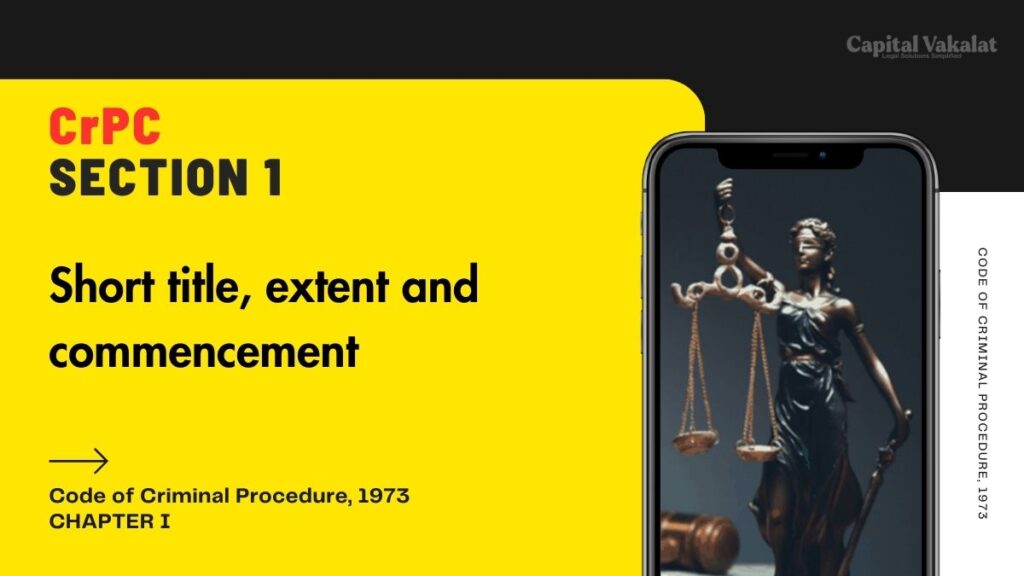The Code of Criminal Procedure (CrPC) is a comprehensive legislation governing criminal procedure in India. Section 1 serves as the introductory provision of the CrPC, setting the stage for the entire legal framework it entails. Understanding the nuances of Section 1 is crucial for legal practitioners, scholars, and anyone interested in the Indian legal system.

Understanding the Short Title
In legal documents, a short title serves as a concise reference to the legislation. Section 1 of the CrPC bears the short title “Title, extent and commencement,” encapsulating the essence of what follows in the subsequent provisions. Short titles facilitate ease of reference and comprehension, streamlining legal discourse and procedures.
Short title, extent and commencement.—
(1) This Act may be called the Code of Criminal Procedure, 1973.
(2) It extends to the whole of India 1 ***:
Provided that the provisions of this Code, other than those relating to Chapters VIII, X and XI thereof, shall not apply—
(a) to the State of Nagaland,
(b) to the tribal areas, but the concerned State Government may, by notification, apply such provisions or any of them to the whole or part of the State of Nagaland or such tribal areas, as the case may be, with such supplemental,
incidental or consequential modifications, as may be specified in the notification. Explanation.—In this section, “tribal areas” means the territories which immediately before the 21st day of January, 1972, were included in the tribal areas of Assam, as referred to in paragraph 20 of the Sixth Schedule to the Constitution, other than those within the local limits of the municipality of Shillong.
(3) It shall come into force on the 1st day of April, 1974.
Extent of Section 1
The extent clause within Section 1 delineates the geographical boundaries within which the CrPC applies. This delineation is essential for determining the jurisdiction of courts and the applicability of procedural provisions. The extent may vary, encompassing specific territories or extending to the entirety of India, depending on the nature of the provision.
Commencement of Section 1
Commencement clauses specify when a law comes into effect. In the context of Section 1, the commencement provision elucidates the date from which the CrPC becomes operational. This clarity is paramount for legal practitioners and citizens alike, ensuring adherence to procedural requirements from the outset.
Historical Context of Section 1
Section 1 of the CrPC has evolved over time, reflecting changes in legal and societal landscapes. Its historical trajectory sheds light on the legislative intent and the socio-political milieu in which it was formulated. Amendments and revisions to Section 1 mirror the dynamic nature of legal systems and the quest for justice.
Key Provisions of Section 1
Within Section 1 lie provisions that lay the groundwork for subsequent chapters and sections of the CrPC. These provisions define the scope, applicability, and commencement of the procedural framework, guiding legal practitioners and stakeholders in their interactions with the law.
Interpretation and Application
Interpreting and applying Section 1 requires a nuanced understanding of legal principles and precedents. Courts play a pivotal role in interpreting the provisions of the CrPC, ensuring consistency and adherence to constitutional values. Real-life cases provide insights into the practical application of Section 1 in diverse legal contexts.
Comparison with Other Legal Frameworks
Comparative analysis of Section 1 with analogous provisions in other legal systems enhances our understanding of its significance and implications. By juxtaposing different legal frameworks, we glean insights into best practices, challenges, and areas for reform within the Indian criminal justice system.
Contemporary Relevance
In today’s fast-paced world, Section 1 remains relevant as ever, shaping the course of criminal proceedings and safeguarding the rights of individuals. Recent developments and debates underscore the need for continuous evaluation and adaptation to meet evolving societal needs and challenges.
Practical Implications for Legal Professionals
Legal professionals must navigate the intricacies of Section 1 with precision and diligence. Familiarity with its provisions, nuances, and interpretations equips practitioners to advocate effectively for their clients and uphold the principles of justice and fairness.
Public Awareness and Education
Enhancing public awareness and legal literacy about Section 1 fosters a more informed and engaged citizenry. Through educational initiatives and outreach programs, stakeholders can empower individuals to navigate the legal landscape with confidence and understanding.
Critiques and Debates
While Section 1 serves as the cornerstone of the CrPC, it is not immune to criticism and scrutiny. Debates surrounding its efficacy, scope, and application prompt introspection and calls for reform to ensure alignment with contemporary legal norms and societal aspirations.
Conclusion
Section 1 of the CrPC epitomizes the foundational principles of procedural justice and legal order. Its provisions, encompassing the short title, extent, and commencement, lay the groundwork for a fair and transparent criminal justice system. As we navigate the complexities of modern-day legal challenges, Section 1 remains a steadfast beacon guiding our quest for justice and equity.
FAQs
Can Section 1 be amended?
Like any other provision of law, Section 1 can be subject to amendments through legislative processes.
What is the significance of the short title in Section 1?
The short title provides a concise reference to the legislation, facilitating ease of reference and comprehension.
How does Section 1 impact legal practitioners?
Legal practitioners rely on Section 1 to determine the jurisdiction and applicability of procedural provisions in criminal cases.
Why is public awareness about Section 1 important?
Public awareness fosters a better understanding of legal rights and obligations, empowering individuals to navigate the legal system effectively.